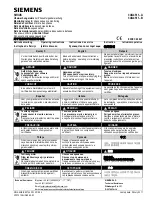
701 Motor Protection Relay
Date Code 20010719
Glossary
Max/Min Meter–Phase Rotation
GL.6
Max/Min Meter
Type of meter data presented by the SEL-701 Relay
that includes a record of the maximum and minimum
of each value, along with the date and time that each
maximum and minimum occurred.
Motor Thermal Element
A motor protection element that measures motor
current, calculates a representation of the energy
dissipated in the motor, and compares the present
energy estimate to trip thresholds defined by the relay
settings. The output of the motor thermal element is
represented as a % Thermal Capacity. When the
% Thermal Capacity reaches 100, the relay trips to
protect the motor. The Motor Thermal Element
provides motor protection for the following conditions
that cause motor overheating: locked rotor, overload
operation, and current unbalance.
NEMA
Abbreviation for National Electrical Manufacturers
Association.
Neutral
Overcurrent Element
A protection element that causes the relay to trip when
the neutral current magnitude (measured by the IN
input) exceeds a user settable value. Used to detect and
trip in response to motor or cable ground faults.
Nominal Frequency
Normal electrical system frequency, usually 50
or 60 Hz.
Nonfail-Safe
Refers to an output contact that is not energized during
normal relay operation. When referred to a trip or stop
output contact, the protected motor remains in
operation unprotected when relay power is removed or
if the relay fails.
Nonvolatile Memory
Relay memory that is able to correctly maintain its data
even when the relay is deenergized.
Overfrequency Element
A protection element that causes the relay to trip when
the measured electrical system frequency exceeds a
user settable frequency.
Phase Reversal Element
A protection element that detects the phase rotation of
the voltage or current signals applied to the protected
motor, and trips if that phase rotation is the opposite of
the desired phase rotation.
Phase Rotation
The sequence of voltage or current phasors in a multi-
phase electrical system. In an ABC phase rotation
system, the B-phase voltage lags the A-phase voltage
by 120°, and the C-phase voltage lags B-phase voltage
by 120°. In an ACB phase rotation system, the C-phase
voltage lags the A-phase voltage by 120°, and the
B-phase voltage lags the C-phase voltage by 120°.
Содержание SEL-701
Страница 12: ...This page intentionally left blank ...
Страница 18: ...This page intentionally left blank ...
Страница 20: ...This page intentionally left blank ...
Страница 36: ...This page intentionally left blank ...
Страница 64: ...This page intentionally left blank ...
Страница 144: ...This page intentionally left blank ...
Страница 198: ...This page intentionally left blank ...
Страница 232: ...This page intentionally left blank ...
Страница 246: ...This page intentionally left blank ...
Страница 346: ...This page intentionally left blank ...
Страница 390: ...This page intentionally left blank ...
Страница 408: ...This page intentionally left blank ...
Страница 410: ......
Страница 412: ......
Страница 414: ......
Страница 416: ......
Страница 418: ......
Страница 420: ......
Страница 422: ......
Страница 424: ......
Страница 426: ......
Страница 428: ......
Страница 430: ......
Страница 432: ......
Страница 434: ......
Страница 436: ......
Страница 438: ......
Страница 440: ......
Страница 442: ......
Страница 452: ...This page intentionally left blank ...
Страница 466: ...This page intentionally left blank ...
















































